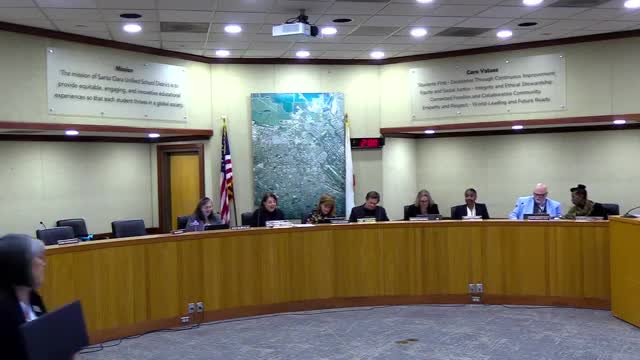School Board reviews adoption of K2 reading difficulty screener by June deadline
April 27, 2025 | Santa Clara Unified, School Districts, California
This article was created by AI summarizing key points discussed. AI makes mistakes, so for full details and context, please refer to the video of the full meeting. Please report any errors so we can fix them. Report an error »

The recent Board Meeting held on April 10, 2025, focused on the urgent adoption of a new reading screener for students in kindergarten through second grade, a decision driven by state mandates aimed at addressing reading difficulties among young learners. The meeting highlighted the necessity of implementing the K-2 reading difficulty screener as part of a broader initiative to enhance literacy support in California schools.
During the meeting, representatives from the Elementary Literacy Work Group presented the need for swift action due to a tight timeline set by the state. Following the passage of Senate Bill 114, which revised education codes, the state mandated that school districts adopt one of the approved screeners by June 30, 2025. This requirement comes after a lengthy selection process that began in January 2024, culminating in the release of a list of approved screeners in December 2024.
The proposed screener is designed to assess both English and non-English speaking students, ensuring that all children receive appropriate support in their primary language when available. The board discussed the importance of integrating this screener into a comprehensive assessment system, emphasizing that it should not be the sole measure of a student's reading abilities. Instead, it will serve as an early indicator of potential reading difficulties, allowing educators to tailor instruction accordingly.
Key next steps outlined during the meeting include determining the optimal timing for administering the screener, particularly for kindergarten students, and establishing a process for families to opt their children out of the assessment if they choose. Reports on assessment results will need to be provided to families within 45 days, ensuring transparency and engagement with parents.
The board's decision to adopt the screener is a significant step towards improving literacy outcomes for young students in the district. As the implementation deadline approaches, educators and administrators are tasked with ensuring that the necessary systems and supports are in place to meet the state's requirements and effectively assist students at risk of reading difficulties. This initiative aligns with broader educational goals to enhance literacy and provide equitable learning opportunities for all students in the community.
During the meeting, representatives from the Elementary Literacy Work Group presented the need for swift action due to a tight timeline set by the state. Following the passage of Senate Bill 114, which revised education codes, the state mandated that school districts adopt one of the approved screeners by June 30, 2025. This requirement comes after a lengthy selection process that began in January 2024, culminating in the release of a list of approved screeners in December 2024.
The proposed screener is designed to assess both English and non-English speaking students, ensuring that all children receive appropriate support in their primary language when available. The board discussed the importance of integrating this screener into a comprehensive assessment system, emphasizing that it should not be the sole measure of a student's reading abilities. Instead, it will serve as an early indicator of potential reading difficulties, allowing educators to tailor instruction accordingly.
Key next steps outlined during the meeting include determining the optimal timing for administering the screener, particularly for kindergarten students, and establishing a process for families to opt their children out of the assessment if they choose. Reports on assessment results will need to be provided to families within 45 days, ensuring transparency and engagement with parents.
The board's decision to adopt the screener is a significant step towards improving literacy outcomes for young students in the district. As the implementation deadline approaches, educators and administrators are tasked with ensuring that the necessary systems and supports are in place to meet the state's requirements and effectively assist students at risk of reading difficulties. This initiative aligns with broader educational goals to enhance literacy and provide equitable learning opportunities for all students in the community.
View full meeting
This article is based on a recent meeting—watch the full video and explore the complete transcript for deeper insights into the discussion.
View full meeting
